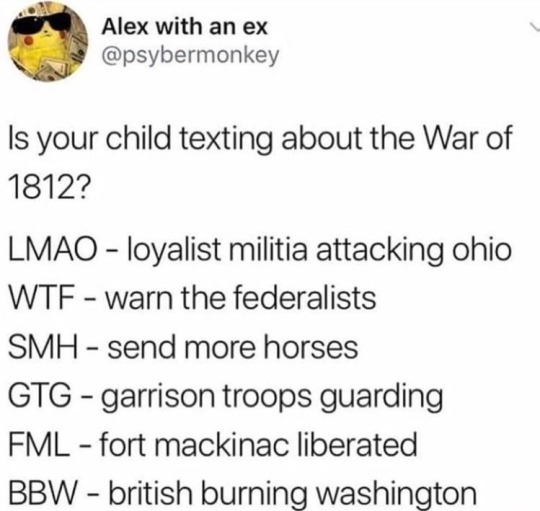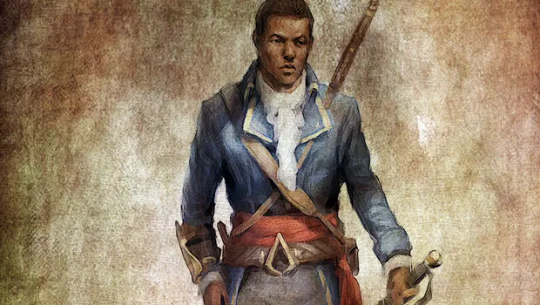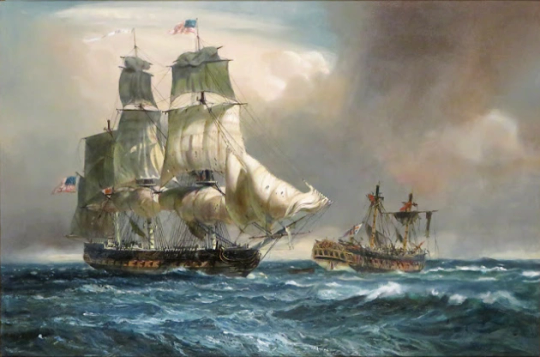#war of 1812
Explore tagged Tumblr posts
Text

Trying to get my redcoats to fortify the camp but they keep lounging insouciantly. :/
#napoleonic#war of 1812#dressed to kill#mad because i can't find an image source#i strongly suspect this is from the the anne s k brown military collection#yes i am sharing this everywhere#redcoats
938 notes
·
View notes
Text

"Battle at Moonlight" by Maarten Platje (1967-)
The painting depicts the action between the sloops USS Wasp & HMS Avon on 1st September 1814.
188 notes
·
View notes
Text

✨I put this to music✨
I've been hearing Fraser repeat this line in my head the entire day.
65 notes
·
View notes
Text




HI GUYS
Sorry now i have a lot of exams so i won't draw for mayve one week sorry😔👎👎 aaaa
Ermolov is too cool for all of us so i ve drawn him (BIG RUSSIAN BOSS🔥🔥🔥), an episode from the book about bagration where (the translation from russian: how he spazzed me out🤬), and murat with na pole on! THEIR HEIGHT DIFFERENCE is SO FUNNY
byee
#pyotr bagration#barclay de tolly#napoleonic wars#napoleon#napoleonic era#war of 1812#joachim murat#ermolov
166 notes
·
View notes
Text

#history#war of 1812#haven’t seen this on tumblr yet but it’s making the rounds on Twitter#amhist#LOYALIST MILITIA ATTACKING OHIO
311 notes
·
View notes
Text

#napoleonic wars#napoleonic era#Alexey arakcheyev#Alexey arakcheev#russian empire#war of 1812#History
90 notes
·
View notes
Text

Pitcher, 1818-25, commemorating the War of 1812.
48 notes
·
View notes
Text
“At the turn of the nineteenth century, the British Empire is at the height of its ascendancy; Napoleonic France is struggling to maintain its position as a world power; and the incumbent American empire is quickly expanding its territory, while the Native peoples struggle to establish their own confederacy, their own independent nation.”
- James Laxer, Tecumseh & Brock: The War of 1812
Spurred by a someone, I bring you a collect of uniforms from the war of 1812. Quite the underrated, set in the lull of the Napoleonic Wars, the smaller and less professional set pieces don’t make it any less heroic.
One of my favourite quotes about the conflict comes from the book above; a man of Issac Brock’s is concerned for his life, telling him to remove his uniform to hide his rank, Issac Brock reproaches him and tells him he would never lead his men anywhere he wouldn’t personally go. He would die in battle; “As was his practice, he would lead from the front, attired in his scarlet uniform. A British quartermaster who had crossed the river with Brock urged him to make himself less of a target for the Americans. “If we lose you, we lose all,” he said to the general, pleading with Brock to let the troops by led by their own officers. “Many here follow me from a feeling of personal regard,” replied Brock. He thanked the quartermaster for his regard but said, “I will never ask them [his soldiers] to go where I do not lead them”
The siege of Detroit was fun too.
From The American War 1812-14






#war of 1812#napoleonic era#napoleonic wars#history#military art#1800s#military#great britain#britain#uniform#united states#cavalry#soldier#military history#British uniform#American uniform
46 notes
·
View notes
Text
Whatever happened to the Davenport Homestead?

Eseosa arriving for training at the Davenport Homestead (c.1804) "Once Connor came along, it flourished again for several decades, even surpassing its former glory. Then, it suddenly vanished early in the 19th century. Any manor that can suddenly vanish is both interesting and unsettling in the same measure, though probably not a great investment." - Shaun Hastings, (c. 2012) [Database: Davenport Homestead]
The mystery of the Davenport Homestead remains one of the most perplexing enigmas within the AC universe, primarily due to the myriad factors that could account for its disappearance. A community and establishment like the Homestead doesn't simply vanish without a significant cause. According to the Initiates website, Connor's last recorded activity took place in 1804, when he trained Eseosa, the grandson of Adewale. Given that the Homestead was still in existence then, its disappearance likely occurred after that date.

The factors leading to the Homestead’s decline may also mirror the complicated legacies of its last known guardians, Connor and Shay. Their parallel narratives set the stage for the tumultuous events during the American Civil War. Shay Cormac, as detailed in the "Last Descendants" novelization, eventually returned to America, living long enough to train his descendants as Assassin Hunters. The ending of Rogue hints at a possible future confrontation between Connor and Shay, which could have contributed to the even decline of the (previously named Colonial) American Brotherhood within New York.

Shay's grandson, Cudgel Cormac (c.1863) | Art by: SunsetAgain
This decline is starkly illustrated by the rise of Varius, one of the few Assassins who survived there into the Civil War era, even with Connor—who revitalized the Brotherhood—at the helm. In contemplating their legacies, one might deduce that Connor and Shay forged a truce between the Assassins and Templars that endured for a significant time before their respective deaths. This possibility aligns with Connor’s rare willingness to seek peace with the Templars, a notion few Assassins entertained before him. Shay, while critical of the flawed ideologies of the Brotherhood under Achilles, would have recognized that Connor’s vision surpassed his mentor’s in prioritizing the welfare of people over rigid allegiances.

Both men shared a deep commitment to doing what was right, irrespective of their differing ideologies. Their interactions may have been marked by meaningful debates about the merits and shortcomings of their respective orders, echoing the possibility of cooperative endeavors throughout history. In Unity, we see hints of such interactions, and even William Miles acknowledges the existence of attempted truces between the Assassins and Templars when questioned by Desmond. This raises the question: could Connor and Shay’s alliance have been one of those fleeting moments of cooperation? However, this perspective does not fully explain the Homestead’s disappearance. Other historical events, such as the War of 1812, Tecumseh's Rebellion, and the earliest form of Manifest Destiny, also loom large in this period, potentially influencing the fate of the Brotherhood and its stronghold. It’s plausible that Connor, much like Altair before him, recognized that the Homestead had become a liability—a beacon that exposed them to their enemies. This awareness might have prompted him to relocate the Colonial Brotherhood to various hidden enclaves across America.

As the notion of Manifest Destiny gained traction, different sects of the American Brotherhood likely experienced varying degrees of success, especially after Connor’s passing left them without an influential leader to guide them amidst the resurgence of Templar influence through members such as William Magear "Boss" Tweed, a powerful business tycoon and politician, and Shay’s descendants. Thus, the interwoven fates of Connor, Shay, and the Davenport Homestead present a complex tapestry of alliances, conflicts, and historical forces that shaped the Brotherhood's legacy during a tumultuous period in American history.
------------------------------------------------------------------------
Davenport Homestead: An Assassin Fake Out? Other sources, such as from former Ubisoft writer James Nadiger, as well as the fourth illustration of the Assassin's Creed Reflections comic, do give the implication that the entire "disappearance" of the Homestead was supposed to be an orchestrated trick from Connor and the Assassins to throw off the scent of the Templars.

James Nadiger: "Connor would have had his family and friends, and the American Assassins would have played pivotal roles in stuff like the War of 1812. And the idea that the Davenport homestead vanished or that he died alone would all be a fake out to throw the Templars off their scent."
Retcons (?) aside, it’s important to note that the Homestead had still vanished by 2012 when Desmond discovered the precursor key left behind by Connor. This only raises several questions to ponder about: 1.) Why the Fake-Out? – If the Homestead’s disappearance was staged, what prompted the Assassins to resort to such drastic measures? Was it a strategic move to protect a (precursor) key asset?
2.) Impact of Historical Events – How did events like Tecumseh’s Rebellion, the War of 1812, or Manifest Destiny possibly influence the decision to abandon or conceal the Homestead?
3.) Connor’s Legacy – Did Connor anticipate the need to decentralize the Brotherhood, moving away from a single stronghold like the Homestead to ensure its survival? On that note, what the hell even happened to Connor?
4.) Templar Influence – How involved were the Templars in the Homestead’s fate? Did Shay, his descendants, or other Templar factions play a role in its disappearance? If not, why does the sudden move happen, as Shaun implies?
5.) Effectiveness of the Ruse – If the disappearance was a ruse, how effective was it? Did it successfully deceive the Templars, or was it only a temporary measure? --------------------------------------------------------------------------
In conclusion, the mystery of the Davenport Homestead's disappearance leaves us with more questions than answers. Whether its vanishing was part of a strategic ruse by the Assassins or influenced by external historical events, the Homestead’s fate remains a key enigma within Assassin's Creed history. As we explore the possible connections between Connor’s legacy, Templar schemes, and the broader forces of Manifest Destiny, it’s clear that the Homestead’s story is intertwined with the survival and evolution of the American Brotherhood during a pivotal time.
#assassin's creed#ratonhnhaké:ton#connor kenway#shay patrick cormac#assassin's creed rogue#american civil war#war of 1812#tecumseh's rebellion#manifest destiny#davenport homestead#templar order#assassin order#assassin's creed 3#templar assassin#fan theory#assassin's creed reflections#assassin's creed descendants#davenport homestead disappearance
29 notes
·
View notes
Text
Fort York, Toronto, Ontario.










#meerathehistorian#john graves simcoe#Fort York#history#early 19th century#19th century#war of 1812#19th century history#canadian history#english history#my photos#photography#regency#toronto#canada#queue are made by history
30 notes
·
View notes
Text






"USS CONSTITUTION, under the command of Captain Isaac Hull, sailed from Boston on August 2, 1812 to off the coast of Halifax, Nova Scotia. On the afternoon of August 19, 1812 Hull and his crew sighted the British frigate HMS GUERRIERE, under the command of Captain James Richard Dacres.
As GUERRIERE closed to within a mile of the CONSTITUTION, the British hoisted their colors the two ships engaged in a fire fight. The CONSTITUTION’s thick hull, composed of white oak planking and live oak frames, proved resilient to enemy cannonballs. During the engagement, an American sailor was heard exclaiming, 'Huzza! Her sides are made of iron! See where the shot fell out!'. After intense combat, the severely damaged Guerriere was forced to surrender.
The next morning, Hull made the difficult decision to scuttle GUERRIERE. CONSTITUTION sailed for Boston and arrived on August 30. News of Constitution‘s victory quickly spread through town and throngs of cheering Bostonians greeted Hull and his crew. A militia company escorted Hull to a reception at the Exchange Coffee House and more dinners, presentations and awards followed in the ensuing weeks, months, and years. USS CONSTITUTION, for her impressive strength in battle, earned the nickname 'Old Ironsides.'"
Date: August 19, 1812
U.S. Naval History and Heritage Command: NH 64419-KN, 66-335-L, 66-335-M, 54-017-A, 66-193-A, 07-763-A, 60-362-C
#USS CONSTITUTION#Old Ironsides#United States Class#44-gun Frigate#Original 6 frigates#HMS GUERRIERE#HMS GUERRIERE (1806)#Fifth-Rate Frigate#Frigate#Warship#Ship#Sailing Ship#United States Navy#U.S. Navy#US Navy#USN#Navy#British Royal Navy#Royal Navy#War of 1812#August#1812#Artwork#Painting#my post
43 notes
·
View notes
Text





Illustrations by Victor Mays for The Battle of Lake Erie by F. van Wyck Mason, 1960.
#war of 1812#age of sail#battle of lake erie#oliver hazard perry#military history#illustrations#naval history#maritime history#great lakes#victor mays#francis van wyck mason#september 10 1813#on this day#this looks like a fun very mid-century novelisation of the battle
192 notes
·
View notes
Text

The USS ‘United States’ Engaging the HMS ‘Macedonian’ , by Leslie Arthur Wilcox, British, 1904-1982, c. 1977
135 notes
·
View notes
Text
I know there was a whole election process but sometimes I’m in disbelief that a little 5’4” man was in charge of a country and actually declared war in 1812.
Like, I need to lie down over this. One only associates him with post Revolutionary War basically. Then when his name comes up in a book during the next war as “president”, I’m STILL like “HUH???”
47 notes
·
View notes
Text







some sketches with my oc, napoleon born to party, barclay and bagration
eshekereee👊🏻👊🏻
115 notes
·
View notes
Text

Pushmataha. Former Chief of the Choctaw and veteran of the War of 1812. Led the Choctaw to ally with the Americans against the British.
Died in 1824 at the age of 60.
#history#art#military history#choctaw#native american#native american history#american art#american history#modern history#chahta#Choctaw history#war of 1812#pushmataha
48 notes
·
View notes